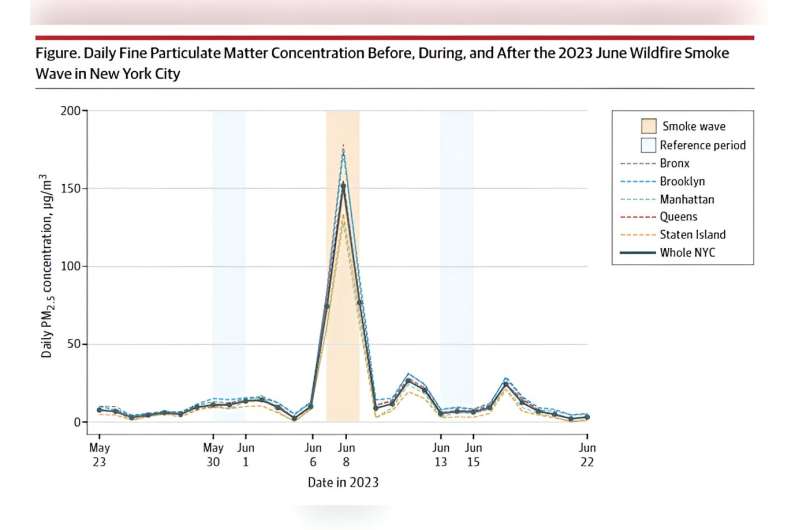With smoke from Canadian wildfires once again descending on the Northeastern United States, residents of New England and New York are being urged to take precautions to protect their health.
While the wildfire smoke is not expected to be as bad as the thick orange haze that permeated the skies over New York City and the New England states last June, a heightened risk for health problems remains—especially among those with certain respiratory conditions.
A new study by researchers at the Yale School of Public Health confirms that harmful smoke from wildfires is capable of traveling great distances and can impact the health of people hundreds of miles away.
The study—recently published in the Journal of the American Medical Association—found a stark association between Canadian wildfire smoke and increases in the number of people being seen for asthma-related symptoms in New York City emergency departments. The research is unique because previous studies on the health impacts of wildfire smoke have focused on areas near the wildfires, but not the broader global regions affected by drifting smoke.
Looking at data from June 2023, the researchers found there was a significant spike in ambient fine particulate matter (PM2.5) in the air over New York City during a smoke wave that dropped down from Canada over a three-day period from June 6 to June 8.
On the same days that the spike in PM2.5 pollution occurred over New York, emergency department visits for asthma-related symptoms jumped to 261 per day across the city, compared with an average of about 182 visits per day during reference periods identified by the researchers before and after the smoke wave. Both the fine particulate matter and the emergency room visits peaked on June 7.
PM2.5 pollution has been shown to affect respiratory health, cardiovascular health, birth outcomes, and mental health, said Kai Chen, an assistant professor of epidemiology (environmental health sciences) at the Yale School of Public Health and the study’s lead author.

The findings should be taken as a word of caution for people living in regions immediately impacted by wildfires as well as those downwind from the fires, the scientists said.
“People should take precautions for wildfire-induced air quality alerts seriously,” Chen said. “This means altering your daily routines as you would do for other extreme events like hurricanes.”
In the study, Chen and his team defined a wildfire smoke wave as a period of at least two consecutive days where the daily mean level of PM2.5 particulate matter exceeded the maximum level—56.8 micrograms per cubic meter (µg/m3)—during a baseline period between Jan. 2021 and May 2023. The daily mean level of PM2.5 pollution from June 6 to June 8 was 100.9 µg/m3, compared with only 9 µg/m3 during the reference period.
The researchers also looked at how the wildfire smoke impacted subgroups in New York City, separating and analyzing data by borough (Bronx, Brooklyn, Manhattan, Queens, and Staten Island) and by age (0–4, 5–17, 18–64, and 65 and over). They found that all boroughs of New York City were impacted by the June smoke wave. All age groups were also affected by the wildfire smoke, but data revealed that people between the ages of 18 and 64 were most likely to visit the emergency department for asthma-related conditions during that time.
Study limitations include data being limited to New York City, the examination of only one acute outcome, and a lack of accounting for changes in population activity patterns or movement.
Amidst the more frequent and larger wildfires in recent years due to a warming climate, the researchers emphasized the need for timely communication about limiting wildfire smoke exposure to protect vulnerable populations.
More information:
Kai Chen et al, Canadian Wildfire Smoke and Asthma Syndrome Emergency Department Visits in New York City, JAMA (2023). DOI: 10.1001/jama.2023.18768
Citation:
Canadian wildfire smoke associated with increased asthma cases in NYC (2023, October 11)
retrieved 11 October 2023
from https://medicalxpress.com/news/2023-10-canadian-wildfire-asthma-cases-nyc.html
This document is subject to copyright. Apart from any fair dealing for the purpose of private study or research, no
part may be reproduced without the written permission. The content is provided for information purposes only.


